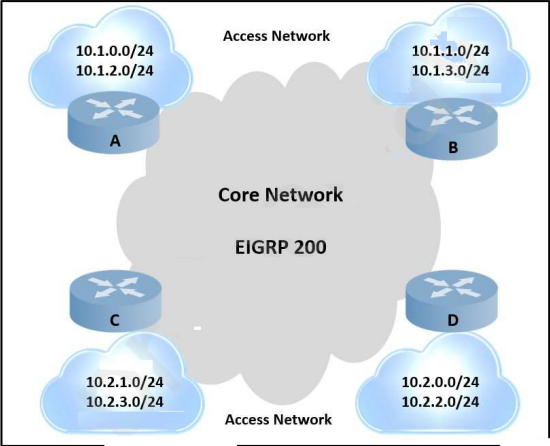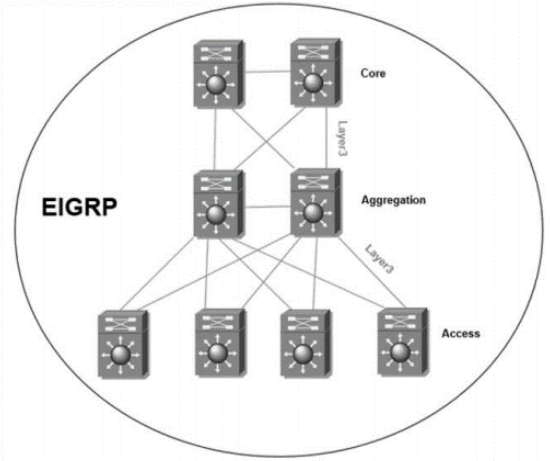Designing Cisco Enterprise Networks Demo Questions
Here you can find Designing Cisco Enterprise Networks exam sample questions which will help you to prepare for your upcoming certification test. These questions will give you an idea of what to expect on the exam and help you review the 300-420 ENSLD study material. Be sure to go over the Free 300-420 ENSLD questions multiple times so that you are confident and comfortable with the material. You can always go to the full 300-420 ENSLD dumps here.
These Designing Cisco Enterprise Networks certification questions are designed to give you a feel for the material you'll be tested on. They cover a wide range of topics, so you can get a sense of what to expect on examination day.
These 300-420 ENSLD dumps are updated regularly, so you can be confident that you're studying with the most up-to-date information available. We also provide answer keys so that students can check their work.
Additionally, going through Designing Cisco Enterprise Networks practice questions can help you identify any areas where you need more review. Taking advantage of our 300-420 ENSLD demo questions is a great way to set yourself up for success on the real thing.
These Designing Cisco Enterprise Networks questions cover the material that will be on the test, and provide an opportunity for students to practice their skills. The questions are designed to be similar to those that will be on the actual Designing Cisco Enterprise Networks exam, so that students can get a feel for what they will be facing. We believe that by providing these demo questions, students will be better prepared and more likely to succeed on their exams.
Good luck for the 300-420 ENSLD exam!
Designing Cisco Enterprise Networks Sample Questions:
1. Refer to the exhibit.

An engineer is designing a routing solution for a customer. The design must ensure that a failure of network 10.1.0.0/24, 10.1.2.0/24, 10.2.1.0/24, or 10.2.3.0/24 does not impact the core. It also requires fast convergence time during any link failover in the core or access networks. Which solution must the engineer select?
A. Add aggregation layer between core and access networks.
B. Enable graceful restart on routers A and C.
C. Enable FRR for the connected networks of routers A and C.
D. Enable summarization on routers A and C.
2. Which OSPF area blocks LSA Type 3, 4 and 5, but allows a default summary route?
A. normal
B. stub
C. NSSA
D. totally stubby
3. Refer to the exhibit.

The full EIGRP routing table is advertised throughout the network. Currently, users experience data loss when any one link in the network fails. An architect optimizes the network to reduce the impact when a link fails. Which solution should the architect include in the design?
A. Run BFD on the inter links between EIGRP neighbors.
B. Summarize the access layer networks from each access layer switch toward the aggregation layer.
C. Reduce the default EIGRP hello interval and hold time.
D. Summarize the access layer networks from the aggregation layer toward the core layer.
4. An engineer is working for a large cable TV provider that requires multiple sources streaming video on different channels using multicast with no rendezvous point. Which multicast protocol meets these requirements?
A. PIM-SM
B. PIM-SSM
C. any-source multicast
D. BIDIR-PIM
5. Which two techniques improve the application experience in a Cisco SD-WAN design? (Choose two.)
A. utilizing forward error correction
B. implementing a stateful application firewall
C. implementing AMP
D. utilizing quality of service
E. implementing Cisco Umbrella
6. The customer solution requires QoS to support streaming multimedia over a WAN. An architect chooses to use Per-Hop Behavior. Which solution should the engineer use to of mark traffic traveling between branch sites?
A. LLQ with DSCP EF
B. CBWFQ with DSCP AF3
C. CBWFQ with DSCP AF2
D. LLQ with DSCP AF4
7. What is the purpose of a control plane node in a Cisco SD-Access network fabric?
A. to maintain the endpoint database and mapping between endpoints and edge nodes
B. to detect endpoints in the fabric and inform the host tracking database of node EID-to-fabric-edge bindings
C. to identify and authenticate endpoints within the network fabric
D. to act as the network gateway between the network fabric and outside networks
8. Which two statements describe source trees in a multicast environment? (Choose two.)
A. Source trees guarantee the minimum amount of network latency for forwarding multicast traffic
B. Source trees create an optimal path between the source and the receivers
C. Source trees use a single common root placed at some chosen point in the network
D. Source trees can introduce latency in packet delivery
E. Source trees can create suboptimal paths between the source and the receivers
9. A customer with an IPv4 only network topology wants to enable IPv6 connectivity while preserving the IPv4 topology services. The customer plans to migrate IPv4 services to the IPv6 topology, then decommission the IPv4 topology. Which topology supports these requirements?
A. dual stack
B. 6VPE
C. 6to4
D. NAT64
10. A customer's current Layer 2 infrastructure is running Spanning Tree 802.1d, and all configuration changes are manually implemented on each switch. An architect must redesign the Layer 2 domain to achieve these goals: (i) reduce the impact of topology changes (ii) reduce the time spent on network administration (iii) reduce manual configuration errors. Which two solutions should the architect include in the new design? (Choose two.)
A. Implement Rapid PVST+ instead of STP.
B. Implement MST instead of STP.
C. Use VTP to propagate VLAN information and to prune unused VLANs.
D. Configure broadcast and multicast storm control on all switches.
E. Configure dynamic trunking protocol to propagate VLAN information.